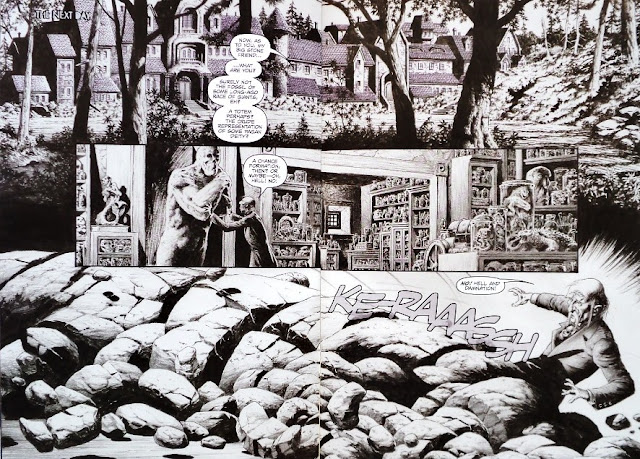We all know that Steve Niles loves the horror genre, and he has produced many horror-themed titles in the past. And Lot 13 had started as the quintessential haunted house story. However, in issue # 2 (originally published in January 2013) we are made privy to the terrible past surrounding the infamous lot 13, and the house built upon it. In a shocking scene, we see two drunk men taking turns and raping a woman. Although it is a violent scene, artist Glenn Fabry manages to depict the moment without making it more explicit than it needs to be. As readers we all understand what’s going on, and we also understand that the ghost of this woman will be forever trapped in the house now visited by the protagonists, along with the people executed during the Fairfax trials.
In issue # 2 (published in February 2013), we see the family desperately fighting to save their lives. Against an unending horde of mutilated and disfigured bodies, it looks as if all hope is lost. Fabry not only provides magnificent covers but also extraordinary and beautiful interior pages; his art shines in every sequence, and makes solid the ethereal concept of ghosts; furthermore, the amount of details, the careful design and the unique balance of every page turn this comic into the kind of work that deserves to be appreciated with our full attention.
A miniseries by such a famous creative team should have been successful but perhaps it didn’t reach its audience due to a series of reason. First of all, it’s a miniseries that would’ve fit well in Wildstorm but that seems slightly out of place under the DC Comics label. But the second reason, and perhaps the most important one, is that around the time the miniseries was published, a number of comic book writers openly complained about the use of rape and promised never to include such scenes in their works. This was one of the many situations in which the division between fiction and reality was forgotten. We can read or write a work of fiction about rape and that doesn’t mean that we condone rape.
However, the premise of some writers was that talking or even mentioning sexual abuse in the pages of a comic book would be an insult to victims of rape, however, this attempt of erasure feeds into the trauma, because in order to heal it’s necessary to remember and to accept what has happened, something which is extremely difficult to victims of sexual abuse who as a psychological defense mechanism deny what happened to them.
________________________________________________________________________________________________
________________________________________________________________________________________________
Hace 8 años, el primer número de Lot 13 fue publicado por DC Comics. Originalmente iba a aparecer dentro del sello Wildstorm, pero terminó como parte de las ofertas regulares de DC ya que Wildstorm había sido eliminado poco tiempo antes, de la misma manera que unos años más tarde Vertigo desaparecería. En el momento en que revisé el primer número, prometí reseñar los siguientes, sin embargo, recién lo estoy haciendo ahora. Entonces, si habéis estado siguiendo este blog desde el 2012, disfrutaréis especialmente de esta publicación.
Todos sabemos que Steve Niles ama el género de terror, y ha producido muchos títulos de terror en el pasado. Lot 13 había comenzado como la típica historia de la casa encantada. Sin embargo, en el número 2 (publicado originalmente en enero de 2013) estamos al tanto del terrible pasado que rodea el infame lote 13, y la casa construida sobre él. En una escena impactante, vemos a dos hombres borrachos turnándose y violando a una mujer. Aunque es una escena violenta, el artista Glenn Fabry logra representar el momento sin hacerlo más explícito de lo que debe ser. Como lectores, todos entendemos lo que está sucediendo y también entendemos que el fantasma de esta mujer quedará atrapado para siempre en la casa que ahora visitan los protagonistas, junto con las personas ejecutadas durante los juicios de Fairfax.
En el número 3 (publicado en febrero de 2013), vemos a la familia luchando desesperadamente por salvar sus vidas. Contra una horda interminable de cuerpos mutilados y desfigurados, parece que se ha perdido toda esperanza. Fabry no solo ofrece portadas magníficas sino también páginas interiores extraordinarias y hermosas; su arte brilla en cada secuencia y hace sólido el concepto etéreo del fantasma; Además, la cantidad de detalles, el diseño cuidadoso y el equilibrio único de cada página convierten este cómic en el tipo de trabajo que merece ser apreciado con toda nuestra atención.
Una miniserie de un equipo creativo tan famoso debería haber tenido éxito, pero tal vez no llegó a su audiencia debido a una serie de razones. En primer lugar, es una miniserie que encajaría bien en Wildstorm pero que parece un poco fuera de lugar bajo la etiqueta de DC Comics. Pero la segunda razón, y quizás la más importante, es que cuando se publicó la miniserie, varios escritores de cómics se quejaron abiertamente sobre el uso de la violación y prometieron nunca incluir tales escenas en sus obras. Esta fue una de las muchas situaciones en las que se olvidó la división entre ficción y realidad. Podemos leer o escribir una obra de ficción sobre la violación y eso no significa que seamos insensibles.
Sin embargo, la premisa de algunos escritores era que hablar o incluso mencionar el abuso sexual en las páginas de un cómic sería un insulto a las víctimas de una violación, sin embargo, este intento de eliminación alimenta el trauma, porque para sanar es necesario recordar y aceptar lo sucedido, algo extremadamente difícil para las víctimas de abuso sexual que, como mecanismo de defensa psicológico, niegan lo que les sucedió.







































